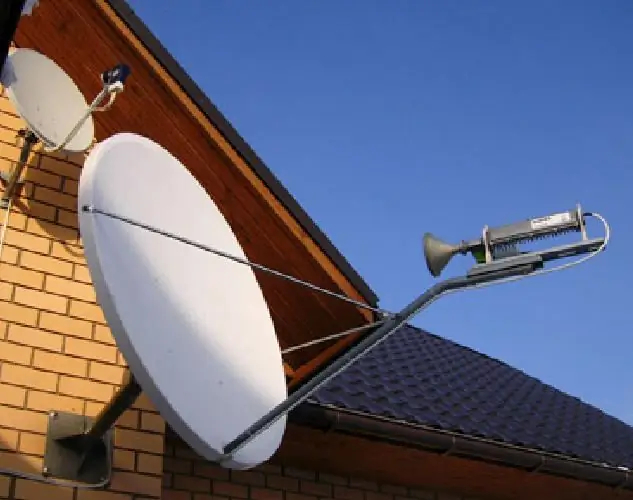- Author Lauren Nevill [email protected].
- Public 2023-12-16 18:48.
- Last modified 2025-01-23 15:15.
For the vast majority of private users, Internet access using a satellite dish is one-way (asymmetric, asynchronous). It requires a "land" line (for the outgoing signal) and satellite-dish communication (for the incoming signal). Satellite Internet is a good option for users who live in places where 3G mobile communication has not yet reached, and there is no way to get a dedicated DSL line.

It is necessary
Offset antenna, converter, cable, DVB network card
Instructions
Step 1
Get access to the Internet using any kind of "terrestrial" connection. Connect to the Internet in any way you can: using Dial-up, GPRS or 3G modems, a dedicated DSL line, etc.
Step 2
Using the existing connection, collect information about satellite providers that provide Internet access services - the name and positioning of their satellites, signal coverage maps, transponder parameters. Check coverage maps to see if your area is within signal range.
The result of collecting information should be a list with the names of providers, names of satellites and parameters of transponders, signals from which are available in your area.
Step 3
Select a specific provider and satellite (transponder).
In order for the antenna to be able to freely receive the signal from the satellite, it should not be closed from it by any obstacles (houses, trees, etc.)
To determine the possibility of receiving a signal from a particular satellite, use the free Satellite Antenna Alignment program. Enter the coordinates of your home (city or village) and satellite into the program. In response to the input, the program will display data on the location of this satellite relative to your home - its azimuth, elevation angle above the horizon, etc. Using this data, check if there are any obstacles in the path of the signal from this satellite to your antenna.
If it turns out that it is possible to receive a signal from several satellites of different providers, opt for the option that will be the most preferable in terms of tariffs.
When making the final choice of the provider and satellite, do not forget to specify the antenna diameter that will be required for high-quality signal reception (determined by the coverage map) and the type of converter required (Ku or C-band), depending on the frequency of the transponder signal.
Step 4
Purchase all the equipment you need.
It includes:
• offset antenna;
• converter;
• antenna cable;
• DVB network card.
When choosing a network card, compare the characteristics of existing cards and choose the most suitable one from your point of view.
Step 5
Mount satellite equipment. Insert the network card into the slot of the computer and install the software for it. Place the antenna where the selected satellite is accessible. Attach the converter to the antenna and connect it with a cable to the network card.
Step 6
Check for satellite signal. Enter the signal parameters: frequency, symbol rate, polarization and information redundancy factor (FEC) into the tuner program of the network card. Align the antenna exactly to the satellite using the data from the Satellite Antenna Alignment software. If the antenna is in the correct position, the tuner program of the network card will record the presence of a signal from the satellite. (The exact procedure for working with the tuner program is specified in the user manual for each specific network card).
Step 7
Subscribe to a satellite provider. After the signal from the satellite is received, go to the website of the satellite provider and register as its client.
After that, an entrance to the user's personal account will be opened for you, in which you will find all the information necessary for further actions: signal PID, IP addresses, possible types of connections, instructions for their installation, methods of payment for services, guidance on all necessary settings.
After completing the selected connection method and paying the required amount for the service, you will get access to the Internet using a satellite.






